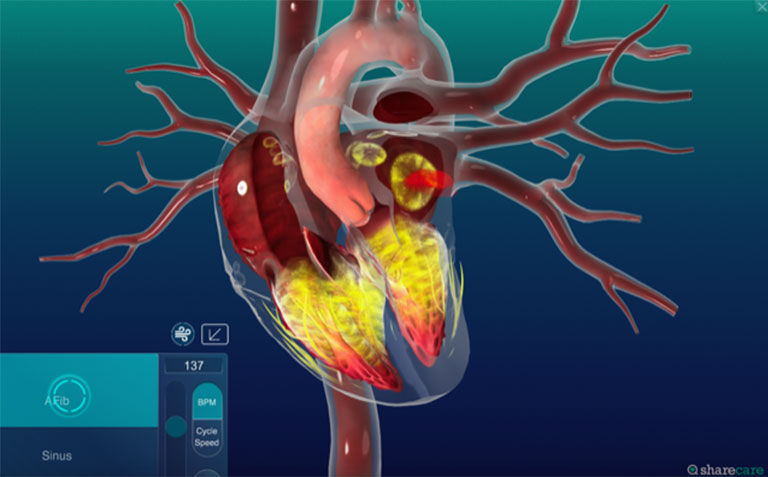Yale PA Online Faculty Member Develops Innovative Curriculum Using 3-D Imaging Software

In summer 2019, Yale Physician Assistant (PA) Online Program students began using an innovative way to learn about the cardiovascular system. Instructor and didactic coordinator Stephanie Neary MPA, MMS, PA-C, developed new curricula, using three-dimensional imaging software, which enabled students to visualize cardiac arrhythmias.
Previously, Neary had utilized lectures and case-based learning styles to deliver content. However, she noticed that students were seeking out supplemental materials online to bring the content alive and visualize disease processes and complications. To ensure that students were using reputable and medically-accurate materials, Neary researched options and discovered software that Sharecare Inc. had developed for the clinical setting. She contacted the company about using the software in an educational setting, leading to a licensing agreement between Yale PA Online and Sharecare.
Sharecare Software Enables Students to Visualize Cardiac Arrythmias
Neary decided to initially focus on cardiac arrhythmias, largely because students typically find it difficult to conceptualize electrophysiology with still images and electrocardiograms (EKGs). Additionally, cardiology is a significant part of the Physician Assistant National Certifying Examination, required to become a certified PA.
With the software imaging, students can see the heart beating, slowed down, with the current going through it with an EKG alongside. The software allows the instructor to pause the imaging to point out specific areas of concern for students. The use of this technology aligns with one of the PA Online Program’s goals to improve pedagogy using innovative technology, and also with the program’s curricular structure of focusing on individual organ systems.
Neary says that utilizing this technology allows the program to “push the envelope for what innovation is and how we deliver curriculum,” adding that “technology changes and learning environments change and the way that students learn is changing, and so we have to continuously, as faculty, evolve in the way we’re teaching the content as well.” The imaging software allows students to utilize a variety of learning styles to engage with the material, which generally has been proven to enhance the student learning experience. Additionally, it reinforces material that was previously only covered in lectures or case studies.

Although student feedback has been largely positive, the Yale PA Online Program is continuing to assess what works with the new technology and focus on areas of improvement. For example, while students did not get to manipulate the software during the summer, they will have the opportunity to do this when they are on campus in December for their second Campus Immersion.
To continue with the development of this curriculum, Neary is working with two students in the program, both former teachers, who are identifying areas where students have struggled conceptually in the past and how the program can use the technology to enhance the learning experience. They also have discussed using the imaging to show processes that are interesting to conceptualize and to highlight what normal looks like.
According to Neary, the long-term goal is to have this technology implemented in each organ system unit, either through a longer lecture block or by using several short videos. Examples of future demonstrations include diabetes, asthma, chronic obstructive pulmonary disease (COPD), atherosclerosis, and breast tumors.
Citation for this content: Yale School of Medicine Physician Assistant Online Program

